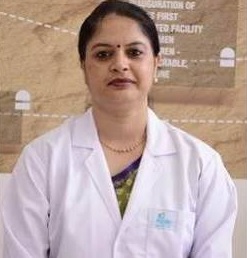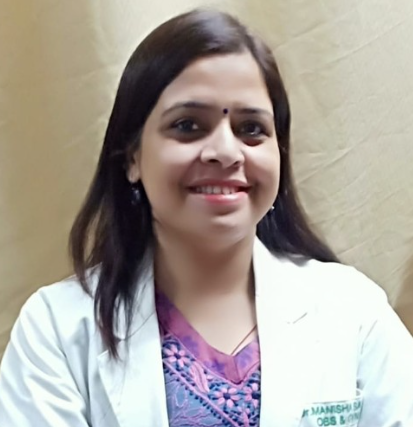Laparoscopic Fibroid Removal - Surgery, Side Effects, Recovery

Treatment Duration
1 Hours
------ To ------3 Hours
Treatment Cost
₹ 45,000
------ To ------₹ 60,000

Table of Contents
- Anatomy and Physiology of the Uterus
- Conditions treated with Laparoscopic Fibroid Removal
- How is Laparoscopic Fibroid Removal performed?
- What to expect before and on the day of Laparoscopic Fibroid Removal?
- What to expect after Laparoscopic Fibroid Removal
- Risks and Complications of Laparoscopic Fibroid Removal
- What will happen if surgery is delayed?
A Uterine Fibroid, also known as leiomyomas or myomas, is a benign (noncancerous)growth of the uterus, either in or around the uterus. Generally, it occurs most commonly in women aged between thirty and forty (child Bearing age). In most conditions, fibroid does not need any surgery. Uterine fibroids are non-cancerous. They are not associated with an increased risk of uterine cancer and almost never develop into cancer.
But in severe conditions, effective treatments are available. Non-surgical methods can decrease pain and bleeding. But sometimes, surgery is necessary to remove the fibroid from the uterus. Laparoscopic fibroid removal surgery is a type of minimally invasive surgery technique. In this method, the fibroid from the uterus is removed by making a small keyhole. Advanced instruments like laparoscopes are used in this technique.
| Procedure Name | Laparoscopic Fibroid Removal |
| Alternative Name |
Myomectomy |
| Conditions Treated |
Bleeding when not on periods, Pain in the lower back, Constipation, Heavy menstrual bleeding, Pain in legs |
| Benefits of Procedure | Minimally Invasive Procedure, Shorter Recovery Time, Lower risk of infection, Less risk of thromboembolism |
| Treated By | Gynecologist |
You can check Laparoscopic Fibroid Removal Cost here.
Anatomy and Physiology of the Uterus
- The uterus is an essential part of the female reproductive system that performs several functions, such as blastocyst implantation and continuation of gestation, and has a role in the menstrual cycle.
- Uterine fibroids are characterised by the growth of noncancerous tissues in the uterus in females of reproductive age. The size of fibroids may vary from very small to large tissue mass.
- The females may have single or multiple fibroids. Multiple fibroids of large size may expand the uterus and increase the overall weight of women.
- Uterine fibroids in several women go undiagnosed and unreported as they usually do not cause symptoms. Symptoms, if present, include heavy bleeding during menstruation, prolonged menstrual periods, frequent urination, pelvic pain, leg pain, and constipation.
Laparoscopic Fibroid Removal Videos by HexaHealth
Expert Doctors (10)
NABH Accredited Hospitals (10)


Conditions treated with Laparoscopic Fibroid Removal
The procedure of laparoscopic fibroid removal may be performed to treat and solve the following symptoms of uterine fibroid:
- Bleeding when you are not on periods
- Pain during sex
- Pain in the lower back
- Constipation
- If you are not able to urinate or unable to empty the bladder
- Heavy menstrual bleeding.
- Pain in legs.
- Laparoscopic fibroid removal includes laparoscopic or robotic myomectomy and laparoscopic or robotic hysterectomy.
How is Laparoscopic Fibroid Removal performed?
The procedure of laparoscopic fibroid removal is as follows:
- This process takes around two to four hours. However, the time may increase if the number of fibroids is more.
- The patient is placed in the lithotomy position.
- A uterine manipulator (A device used to hold the muscles for better viewing) is inserted inside the uterus for controlling the position of the uterus.
- A small cut is made above the naval. Then, three more cuts are made on the abdominal region of the patient. These cuts are made such that it forms a triangular confirmation.
- Then the surgeon inserts a laparoscope (a thin and flexible tube with a camera and light at its head) into the abdominal cavity.
- Other instruments like forceps are inserted through other pores.
- A suturing thread is then passed through each fibroid, and after that, all the fibroids are cut.
- After passing the thread through all the fibroids, the uterine manipulator is removed from its place.
- Then the surgeon cuts the fibroids present in the uterus.
- Then an exit portal is created in the vaginal area.
- Then, all the fibroids are withdrawn through the vaginal exit.
- After this, all the cuts are sutured using a dissolvable thread.
What to expect before and on the day of Laparoscopic Fibroid Removal?
Before Laparoscopic Fibroid Removal
Before starting the surgery, the surgeon may advise you to undergo laboratory tests. It is done to know the stage of fibroid in a better way. They may order tests like:
- Ultrasonography: This is a non-invasive test. It creates an image of internal organs.
- CT scan: It uses x-rays to provide an image of the internal organs.
- MRI scan: It uses magnetic beams and radio waves to deliver a high-quality image of internal organs.
- Laparoscopy: This uses a thin tube with a camera and a light at its tip to view the fibroids present.
The doctor may ask you to stop drinking and eating from midnight before the day of surgery. The doctor may also ask you to stop taking some medicines, like aspirin, ibuprofen and blood thinners, that increase risk of bleeding.
On the day of Laparoscopic Fibroid Removal
- When you reach the hospital, a staff member will help you to perform formalities, such as filling the informed consent form. It helps in confirming the information of the patient.
- Always wear comfortable and loose cloth when going for surgery.
- Leave contact lenses, cosmetics, and jewellery at home.
- A nurse will guide you to the pre-operative area. There you will be asked to change into a gown.
- They will then check the vital signs like blood pressure and pulse rate of the patient.
- The staff will cross-check the information about the patient, like date of birth, father's name, and name of the procedure.
- Then they will place an intravenous line on the arm, and the patient will be wheeled into the surgery room.
During the Surgery
- The procedure of laparoscopic fibroid removal is done under the influence of general anaesthesia. That is why you will not feel any kind of pain or sensations.
- An intravenous line will be inserted into your arm. It is used to deliver the medicines if required in between the surgery.
- A thin tube will be inserted into the mouth after giving anaesthesia. It is done for easing breathing during operation.
- The size of cuts made is about 1 centimetre or less.
- All the vital signs like blood pressure, pulse rate and heart rate are continuously monitored during the surgery.
What to expect after Laparoscopic Fibroid Removal
After the Sugery
- During discharge from the hospital, the doctor will prescribe some medicines to reduce the pain after the operation.
- The doctor may give you some advice regarding care at home. He will also discuss with you the restrictions in diet and activities.
- You may experience staining and vaginal spotting up to six weeks after the surgery.
First Follow-up Appointment
You may expect the following regarding your first follow-up visit:
- The doctor will provide you with the date of the follow-up visit. Do not miss the follow-up visit.
- During the follow-up consultation, the doctor will examine your overall health.
- The doctor will evaluate the incision possible for inflammation or pus formation.
- You may also ask questions if you have any concerns or you are experiencing symptoms.
- The usual follow-up visit would be within 4-6 weeks after the surgery.
Risks and Complications of Laparoscopic Fibroid Removal
Consult the doctor immediately if you are experiencing any of the following symptoms after the completion of surgery:
- Bleeding
- Infection in the wound
- Difficulty urination
- Irregular bowel movement
- Damage to your internal organs like abdomen or bowel (often indicated by persistent high fever).
- No improvement in symptoms.
What will happen if surgery is delayed?
If the laparoscopic fibroid removal surgery is delayed, then it may lead to the following types of complications:
- Anaemia (drop in red blood cells count)
- Fatigue.
- Premature delivery of the baby. It is due to a decrease in space in the uterus due to the presence of fibroid.
- The presence of fibroid in the uterus can also restrict the growth of the foetus.
- Severe pain or heavy bleeding that may require immediate surgery
- Twisting of ovary ( ovary torsion), which may cause severe pain
- The prolonged presence of fibroid can also lead to infertility.
- Urinary tract infection.
- Infertility
- Heavy Menstruation
- Constipation
- Frequent Urination
- Difficulty emptying the urinary bladder
Frequently Asked Questions (FAQ)
What are some Myths and Facts about Laparoscopic Fibroid Removal?
- Myth: Invasive surgery is the only way to treat uterine fibroid.
Fact: If surgery is the option, then minimally invasive surgeries like laparoscopic and robotic surgeries are available. These surgeries are done just by making a keyhole incision.
Last Updated on: 31 January 2024
Author
HexaHealth Care Team
HexaHealth Care Team brings you medical content covering many important conditions, procedures falling under different medical specialities. The content published is thoroughly reviewed by our panel of qualified doctors for its accuracy and relevance.
Other Treatments in Your City





























